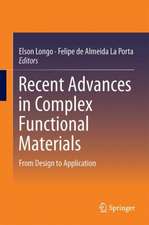Metal Oxide Nanoparticles in Organic Solvents: Synthesis, Formation, Assembly and Application: Engineering Materials and Processes
Autor Markus Niederberger, Nicola Pinnaen Limba Engleză Paperback – 14 mar 2012
In the last few years, a valuable alternative to the well-known aqueous sol-gel processes was developed in the form of nonaqueous solution routes. Metal Oxide Nanoparticles in Organic Solvents reviews and compares surfactant- and solvent-controlled routes, as well as providing an overview of techniques for the characterization of metal oxide nanoparticles, crystallization pathways, the physical properties of metal oxide nanoparticles, their applications in diverse fields of technology, and their assembly into larger nano- and mesostructures.
Researchers and postgraduates in the fields of nanomaterials and sol-gel chemistry will appreciate this book’s informative approach to chemical formation mechanisms in relation to metal oxides.
| Toate formatele și edițiile | Preț | Express |
|---|---|---|
| Paperback (1) | 941.50 lei 6-8 săpt. | |
| SPRINGER LONDON – 14 mar 2012 | 941.50 lei 6-8 săpt. | |
| Hardback (1) | 948.16 lei 6-8 săpt. | |
| SPRINGER LONDON – 10 sep 2009 | 948.16 lei 6-8 săpt. |
Din seria Engineering Materials and Processes
-
 Preț: 397.54 lei
Preț: 397.54 lei - 18%
 Preț: 1237.93 lei
Preț: 1237.93 lei - 18%
 Preț: 950.52 lei
Preț: 950.52 lei - 15%
 Preț: 646.30 lei
Preț: 646.30 lei - 18%
 Preț: 1383.00 lei
Preț: 1383.00 lei - 18%
 Preț: 1826.07 lei
Preț: 1826.07 lei - 5%
 Preț: 676.33 lei
Preț: 676.33 lei - 18%
 Preț: 1237.80 lei
Preț: 1237.80 lei - 18%
 Preț: 1228.62 lei
Preț: 1228.62 lei - 15%
 Preț: 644.95 lei
Preț: 644.95 lei - 15%
 Preț: 636.63 lei
Preț: 636.63 lei - 18%
 Preț: 1217.41 lei
Preț: 1217.41 lei - 20%
 Preț: 337.00 lei
Preț: 337.00 lei - 20%
 Preț: 557.20 lei
Preț: 557.20 lei - 15%
 Preț: 644.18 lei
Preț: 644.18 lei - 18%
 Preț: 956.50 lei
Preț: 956.50 lei - 18%
 Preț: 781.31 lei
Preț: 781.31 lei - 15%
 Preț: 640.06 lei
Preț: 640.06 lei - 23%
 Preț: 691.72 lei
Preț: 691.72 lei - 18%
 Preț: 945.30 lei
Preț: 945.30 lei - 18%
 Preț: 952.09 lei
Preț: 952.09 lei - 15%
 Preț: 635.31 lei
Preț: 635.31 lei - 18%
 Preț: 1383.81 lei
Preț: 1383.81 lei - 15%
 Preț: 644.95 lei
Preț: 644.95 lei - 18%
 Preț: 1222.45 lei
Preț: 1222.45 lei - 18%
 Preț: 1381.88 lei
Preț: 1381.88 lei - 18%
 Preț: 945.30 lei
Preț: 945.30 lei - 15%
 Preț: 640.02 lei
Preț: 640.02 lei - 18%
 Preț: 1545.72 lei
Preț: 1545.72 lei - 24%
 Preț: 848.84 lei
Preț: 848.84 lei - 18%
 Preț: 937.05 lei
Preț: 937.05 lei - 18%
 Preț: 1115.14 lei
Preț: 1115.14 lei - 15%
 Preț: 632.55 lei
Preț: 632.55 lei - 18%
 Preț: 948.79 lei
Preț: 948.79 lei
Preț: 941.50 lei
Preț vechi: 1148.18 lei
-18% Nou
Puncte Express: 1412
Preț estimativ în valută:
180.15€ • 188.60$ • 149.07£
180.15€ • 188.60$ • 149.07£
Carte tipărită la comandă
Livrare economică 05-19 aprilie
Preluare comenzi: 021 569.72.76
Specificații
ISBN-13: 9781447125099
ISBN-10: 1447125096
Pagini: 232
Ilustrații: XIII, 217 p.
Dimensiuni: 155 x 235 x 12 mm
Greutate: 0.33 kg
Ediția:2009
Editura: SPRINGER LONDON
Colecția Springer
Seria Engineering Materials and Processes
Locul publicării:London, United Kingdom
ISBN-10: 1447125096
Pagini: 232
Ilustrații: XIII, 217 p.
Dimensiuni: 155 x 235 x 12 mm
Greutate: 0.33 kg
Ediția:2009
Editura: SPRINGER LONDON
Colecția Springer
Seria Engineering Materials and Processes
Locul publicării:London, United Kingdom
Public țintă
ResearchCuprins
Aqueous and Nonaqueous Sol-Gel Chemistry.- Surfactant-Assisted Synthesis.- Solvent-Controlled Synthesis.- Reaction Mechanism.- Assembly.- Characterization.- Properties and Applications.- Summary, Conclusion and Outlook.
Notă biografică
Markus Niederberger is assistant professor at the Laboratory for Multifunctional Materials in ETH Zurich. Prior to his time at Zurich he spent four years as group leader at the Max Planck Institute of Colloids and Interfaces at Potsdam, Germany.
Nicola Pinna is a senior research in the department of chemistry and CICECO at the University of Aveiro, Portugal. He previously spent time at the Max Planck Institute of Colloids and Interfaces, where he was a research associate, and then went on to become a guest scientist at the Max Planck Institute of Microstructure Physics, Halle.
Nicola Pinna is a senior research in the department of chemistry and CICECO at the University of Aveiro, Portugal. He previously spent time at the Max Planck Institute of Colloids and Interfaces, where he was a research associate, and then went on to become a guest scientist at the Max Planck Institute of Microstructure Physics, Halle.
Textul de pe ultima copertă
The synthesis of nanoparticles with control over particle size, shape, and crystalline structure, has long been one of the main objectives in chemistry – and yet these materials are only beginning to be used in nanotechnology. Metal oxides play a significant role in many fields of technology including catalysis, sensing, energy storage and conversion, and electroceramics. It is expected that they could show enhanced or even new properties at the nanoscale. Metal Oxide Nanoparticles in Organic Solvents discusses recent advances in the chemistry involved for the controlled synthesis and assembly of metal oxide nanoparticles, the characterizations required by such nanoobjects, and their size and shape depending properties.
Innovative strategies have to be developed to allow good control from the molecular precursor to the final product at low processing temperatures. In the last few years, a valuable alternative to the well-known aqueous sol-gel processes was developed in the form of nonaqueous solution routes, which can roughly be divided into two methodologies; namely surfactant- and solvent-controlled preparation routes. Metal Oxide Nanoparticles in Organic Solvents reviews and compares surfactant- and solvent-controlled routes, as well as providing an overview of the most important techniques for the characterization of metal oxide nanoparticles, crystallization pathways, the physical properties of metal oxide nanoparticles, their applications in diverse fields of technology, and their assembly into larger nano- and mesostructures.
Researchers and postgraduates in the fields of nanomaterials and sol-gel chemistry will appreciate this book’s informative approach to chemical formation mechanisms in relation to metal oxides.
Innovative strategies have to be developed to allow good control from the molecular precursor to the final product at low processing temperatures. In the last few years, a valuable alternative to the well-known aqueous sol-gel processes was developed in the form of nonaqueous solution routes, which can roughly be divided into two methodologies; namely surfactant- and solvent-controlled preparation routes. Metal Oxide Nanoparticles in Organic Solvents reviews and compares surfactant- and solvent-controlled routes, as well as providing an overview of the most important techniques for the characterization of metal oxide nanoparticles, crystallization pathways, the physical properties of metal oxide nanoparticles, their applications in diverse fields of technology, and their assembly into larger nano- and mesostructures.
Researchers and postgraduates in the fields of nanomaterials and sol-gel chemistry will appreciate this book’s informative approach to chemical formation mechanisms in relation to metal oxides.
Caracteristici
Discusses recent advances in the chemistry involved in the controlled synthesis and assembly of metal oxide nanoparticles, the characterisation required by such nanoobjects, and their size- and shape-dependent properties Includes supplementary material: sn.pub/extras
















